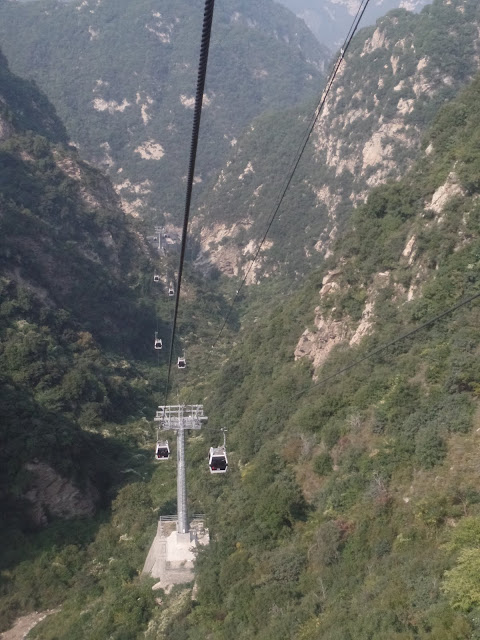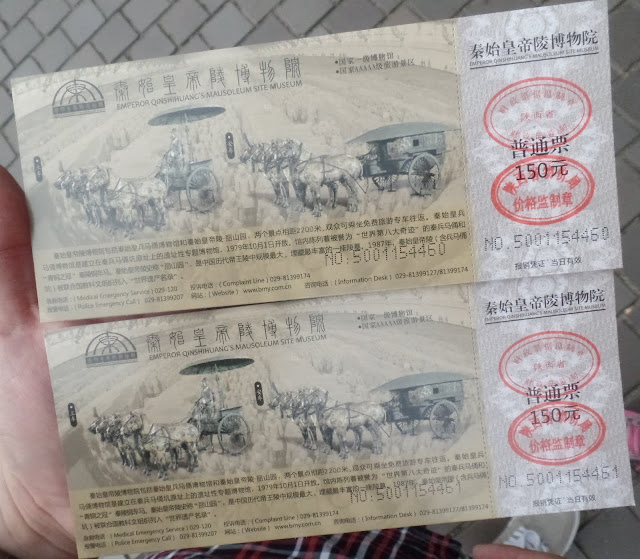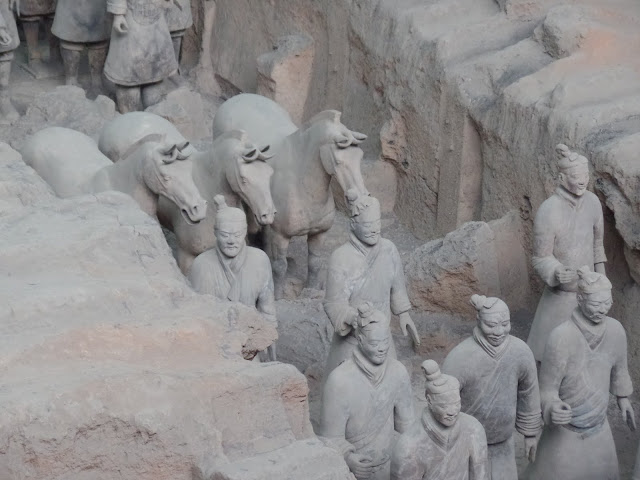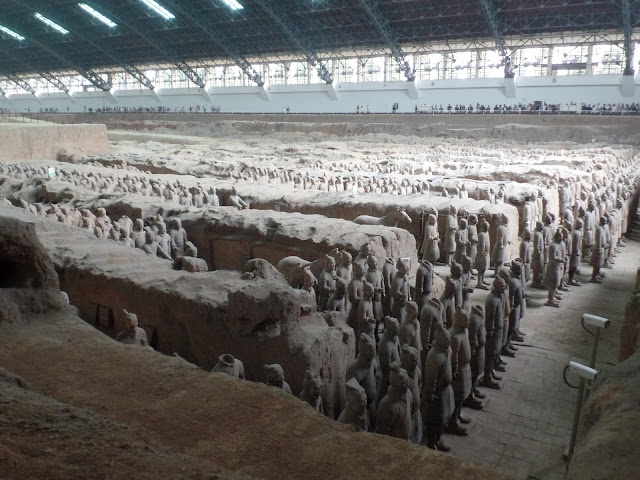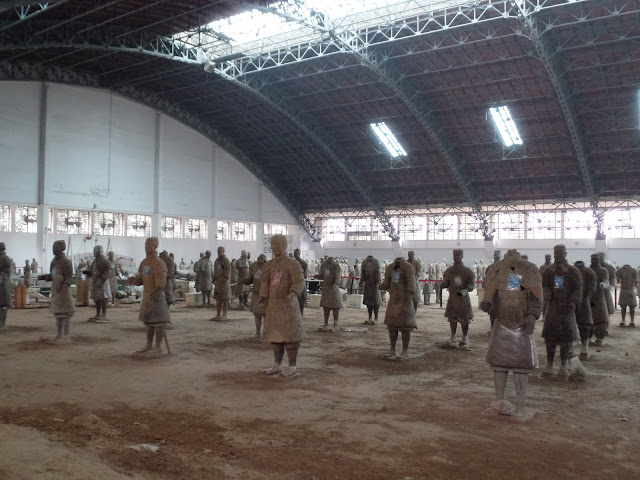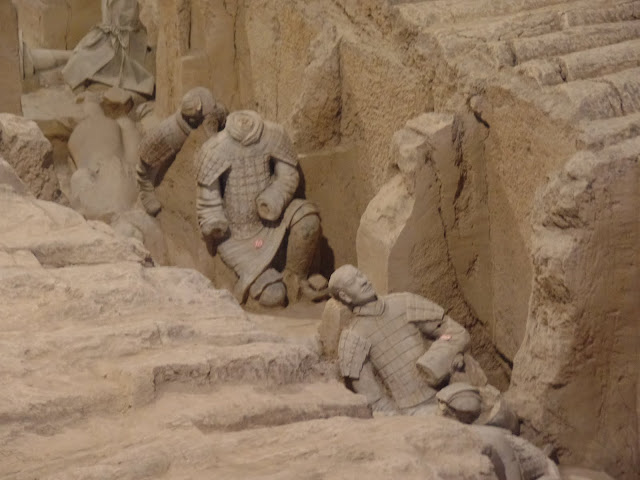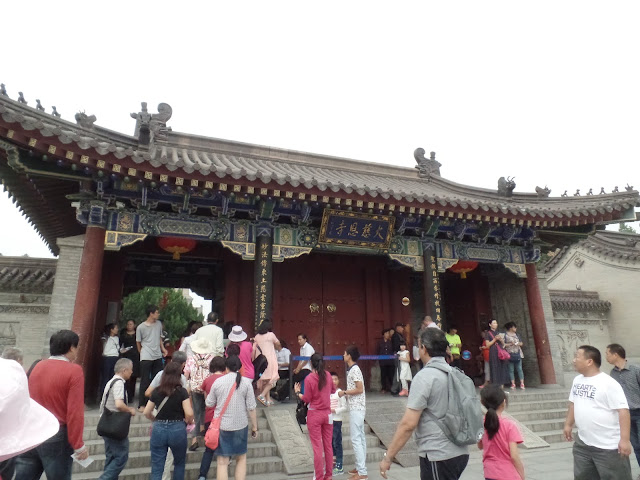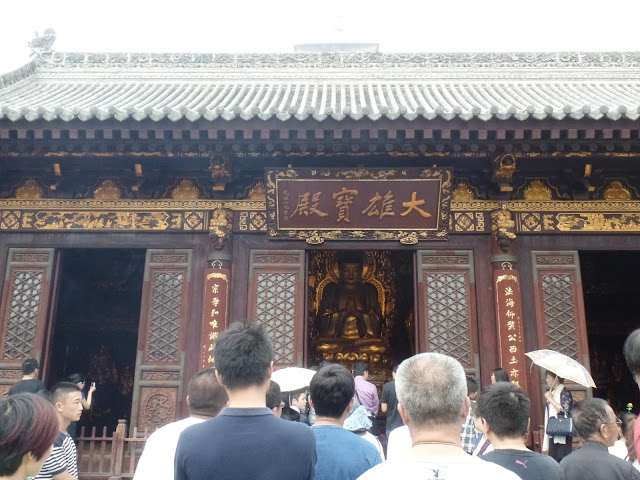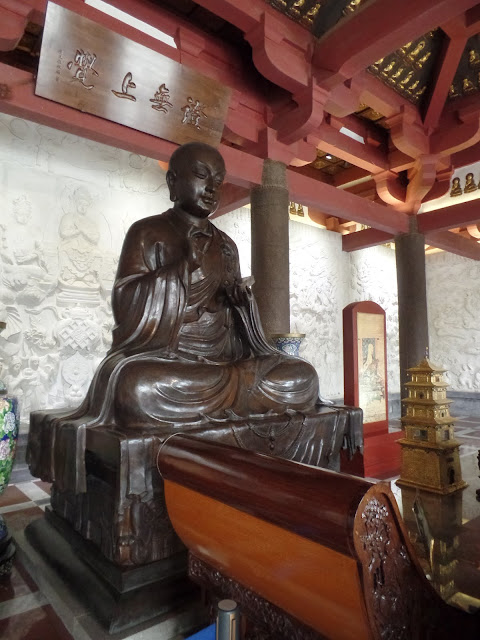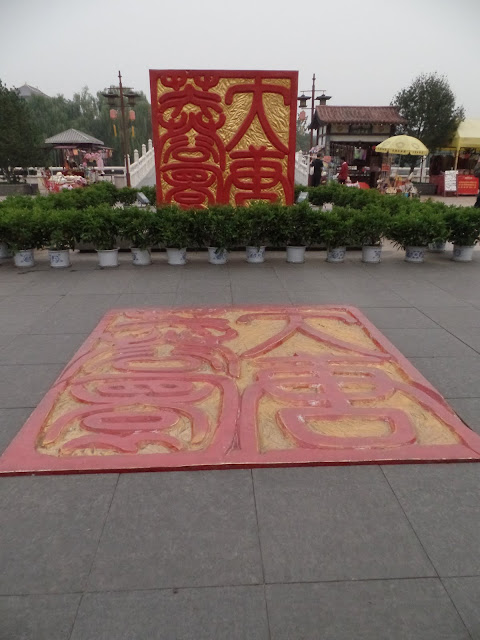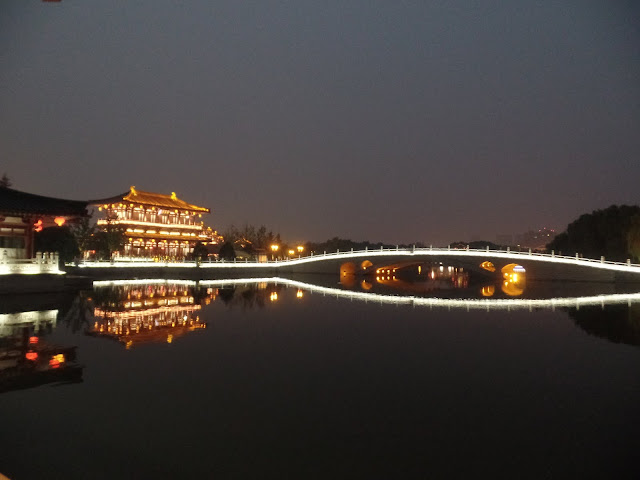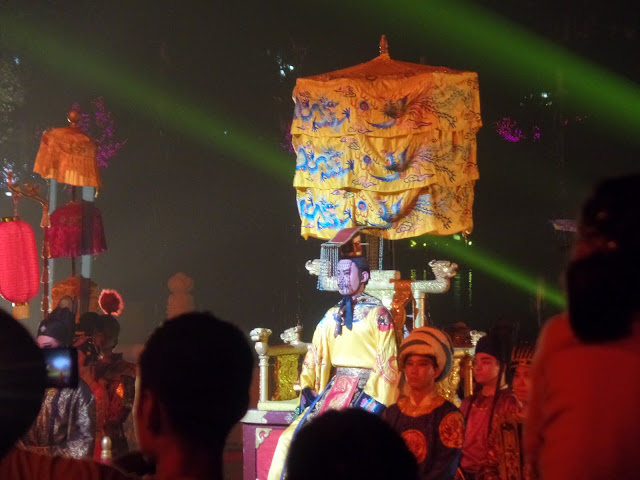On Day 6, we embarked on the most tricky and challenging part of our China tour, which was an one day hiking trip to Mount Hua (Huashan 华山). It was tricky because it was difficult to reach Huashan (华山) from Xi'an, as we had to interchange between several modes of transportation before we could reach there. It was challenging because it was physically demanding to scale the mountain. Huashan (华山) is one of the 5 Great Mountains in China (the others are Mount Tai, Heng, Heng and Song), with its highest point at South Peak (南峰) (2154.9 metres). Huashan (华山) is also referenced in the famous "Sword Meet at Huashan" (华山论剑) of Jin Yong's (金庸) Chinese martial art novels.
There are several ways to ascend and tour the mountain. We have researched the routes and planned accordingly based on our physical fitness level and the available time we have. The general route will be to ascend the mountain via the cable car to the West Peak (西峰), then tour in the order of West Peak (西峰), South Peak (南峰), East Peak (东峰), Central Peak (中峰) and lastly North Peak (北峰). From North Peak (北峰), we will descend the mountain via the cable car there. This route is less strenuous as the overall route is descending (from Central Peak to North Peak). If one goes the other direction, that would mean climbing up a lot of stairs instead. It's definitely easier to climb down then climbing up the stairs. There are several dangerous passes on the mountain, but it is optional to scale them. There are safe alternatives routes and stairs with railings to these passes. For us, we won't be trying these dangerous passes.
 |
| My Huashan Hiking Route |
Huashan (华山)
We woke up very early in the morning to catch the first train (6.30am) at Zhonglou Zhan (钟楼) to Bei Kezhan (北客站). We ate breakfast at KFC in the Xi'an North Railway Station (西安北站). We also takeaway some KFC chicken burgers as our lunch later at Huashan (华山), as there's not much food choices on top of the mountain. We departed the station at 7.50am via the high speed train on a half an hour journey to Huashanbei Railway Station (华山北站). Once we exited the station, we could see the carpark across the large square. Over there, we could find the green shuttle bus that will take us to the Huashan Visitor Centre (华山旅客中心). This shuttle service is free of charge and took around 20 min.
At the Huashan Visitor Centre (华山旅客中心), this is where we have to purchase the entrance tickets to Huashan (华山). On top of that, we could also buy the tickets for another shuttle bus ride to either the cable car station to the North Peak (北峰) or the cable car station to the West Peak (西峰). We bought the shuttle bus tickets to the cable car station to West Peak (西峰). At the bus terminal, the blue shuttle bus goes to the cable car station to West Peak (西峰), while the gold shuttle bus goes to the cable car station to North Peak (北峰). We boarded the blue shuttle bus for another 45 min of bus ride to the cable car station. The place where the blue shuttle bus terminated is not the cable car station yet. We had to further climb several fleet of stairs before we reached the ticketing office. After around 20 min, we finally reached the cable car station and bought the cable car tickets.
 |
| Gateway to the Huashan West Peak Cable Car Lower Station |
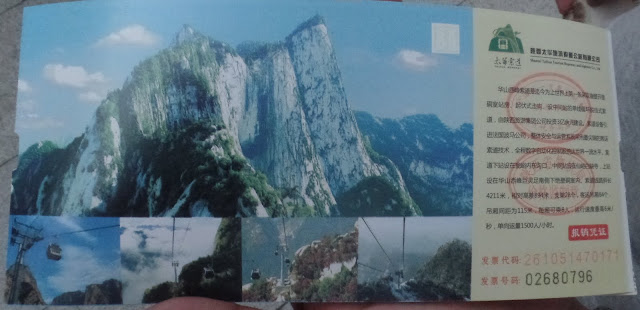 |
| Huashan West Peak cable car tickets |
 |
| Huashan West Peak Cable Car Lower Station |
West Peak (西峰)
The entire cable car ride to the upper station is 4211 metres long and took around 20 min. Throughout the journey, we could enjoy the great scenery, starting from lush green vegetation to the precipitous cliffs nearer the upper station.
Once we exited the cable car upper station, we could feel the air is much cooler and thinner as well. We could also see clear directional signs (with proper English translation) to guide the visitors to various attractions.
From the cable car station, we started the proper hiking at around 10.50am towards the West Peak (西峰). After winding up through the vegetation, we came to an open area where there's a path along the mountain ridge up towards the Cuiyun Palace (翠云宫), which is a Taoist temple. The "stairs" are simply steps cut into the ground. The pathway is around 2-3 metres wide with iron chains on both sides as the barrier.
Around the Cuiyun Palace (翠云宫), there are several large rocks where visitors could climb onto them. The highest point (2086.2 metres) of West Peak (西峰) is located at one of the rock. The view here is magnificent, overlooking at other lower mountain peaks.
We rested at Cuiyun Palace (翠云宫) for a while before we descended through the same mountain ridge path and turned to the other direction towards the South Peak (南峰).
 |
| Leaving the Lower Station |
 |
| Approaching the Upper Station |
 |
| Entrance to the West Peak Cable Car Upper Station |
 |
| Direction sign boards |
 |
| View of the cable cars from the Upper Station |
 |
| Ridge path way up West Peak |
 |
| West Peak Cuiyun Palace |
 |
| Visitors climbing up the big rock at West Peak |
 |
| View from West Peak |
 |
| View of West Peak en-route South Peak |
Along the way, we passed by a place with a furnace, known as the Immortality Pill Making Furnace (炼丹炉), which is not too far away from the highest point (2154.9 metres) of South Peak (南峰).
We climbed to the highest point and took photos together with the tablet. From there, we also had a good view of the West Peak (西峰).
We did not stay long at the highest point as it was quite crowded. We continued our journey towards the East Peak (东峰), which is located quite far away from the South Peak (南峰).
We passed by another temple known as the Heavenly South Gate (南天门), which leads to the famous attraction of the South Peak (南峰), the Cliffside Plank Path (长空栈道). The Cliffside Plank Path (长空栈道) is touted as the world's most dangerous trail. From what I understand, anyone who wants to attempt this trail must rent a harness that comes with two carabiner hooks, which one of them must be hooked to the "safety line" along the trail at any point of time. One has to descend down a series of iron bar ladder before reaching the plank path that skirts around the perimeter of the cliff. The wooden plank path is around one foot wide and is only supported by metal bars nailed onto the cliff. To make things even more challenging, the plank path is two-way traffic, one has to criss cross with other people who are moving in the opposite direction. At the end of the plank path is a small shrine, after which one has to turn back using the same path.
When we reached the location, there's already a long queue of daredevils waiting to challenge the trail.
We only took pictures around the area and continued to descend downhill. We found some benches along way and decided to rest and have our lunch (the takeaway KFC chicken burger).
East Peak (东峰)
 |
| Immortality Pill Making Furnace |
 |
| Introduction to the Immortality Pill Making Furnace |
 |
| Introduction to South Peak |
 |
| South Peak highest point tablet |
 |
| View of West Peak from South Peak |
 |
| View of ridge path way uphill towards the East Peak |
 |
| Route down to the Plank Path (Photo from Rolling Stone Chronicles) |
 |
| Huashan South Peak Cliffside Plank Path (Photo from Gopole.com) |
 |
| Long queue waiting to challenge the Cliffside Plank Path |
East Peak (东峰)
The way to the East Peak (东峰) is a long uphill hike, which we had to make several stops along the way to rest our aching legs.
Upon reaching the East Peak (东峰), highest point at 2096.2 metres), one could see the scenic Chess Pavilion (下棋亭), standing alone on top of the cliff. The only way to get to the Chess Pavilion (下棋亭) is to pass through the "Sparrowhawk Flips Over" (鹞子翻身), which is another dangerous cliff path. One would also need to rent a harness to descend down the cliff.
After this, we proceeded to the Central Peak (中峰), which the route is generally descending from here onward.
Central Peak (中峰)
Along the way, we passed by another interesting pass known as the Cloud Ladder (云梯), which is an almost vertical ladder pass with steps carved from the stone wall. Over here, there's no harness used and visitor has to hold on tight to the iron chains by the sides while climbing. We did not attempt this bypass using the proper staircase beside.
The Central Peak (中峰) itself, highest point at 2037.9 metres, is surrounded by the other 3 peaks, thus there's no great scenery here. There's only one Taoist temple called the Jade Maiden Temple (玉女祠).
We had a long rest along the stairs, where we saw many visitors trekking up from the direction of the North Peak (北峰). After the rest, we continued the journey to the Golden Lock Pass (金锁关), where one could easily observe the large quantities of golden locks with red ribbons locked to two sides of the iron chains. Couples could buy the locks and inscribe their names on them as a symbol of everlasting love.
After the pass, it is all the way descending towards the North Peak (北峰).
North Peak (北峰)
Along the way, we passed by the Five Cloud Peak Hotel before the famous Cang Long Ling (苍龙岭), also known as the "Black Dragon Ridge". It is a very narrow pathway carved onto the mountain ridge, with steep cliffs on both sides. We did not use this pass, instead going down using another alternative path by the side of the ridge.
Upon reaching the foot of the ridge, we finally had a sight of our end point at the North Peak Cable Car Upper Station.
It was another several hundred metres of walk before we reached the North Peak (北峰), highest point at 1614.9 metres. We made the last rest stop and after which we decided to bid farewell to Huashan (华山). We had completed the hike to all the 5 peaks within 5 hours, at the expense of our weary and aching pair of legs.
Back to Xi'an (西安)
We bought the cable car tickets and descended to the lower station. The cable car ride is much shorter than the one at West Peak (西峰), only around 8 min. At the cable car lower station, we purchased another set of shuttle bus tickets and ride onto the gold shuttle bus back to the Huashan Visitor Centre (华山旅客中心). From the Visitor Centre carpark, we took the free shuttle bus back to the Huashanbei Railway Station (华山北站). As we had already purchased our train tickets, it was still very early. We had an early dinner at one of the noodle restaurant just outside of the railway station. After the dinner, we waited some more before taking the high speed train back to Xi'an, followed by the Metro to our hotel area. It was still early and we decided to shop for souvenirs at the Muslim Street (回民街) before we depart Xi'an the next day.
 |
| View of East Peak and the Chess Pavilion (right) |
 |
| Scenic view en-route East Peak |
 |
| Chess Pavilion |
 |
| Two trekkers en-route Chess Pavilion |
 |
| Route down the "Sparrowhawk Flips Over" |
Central Peak (中峰)
Along the way, we passed by another interesting pass known as the Cloud Ladder (云梯), which is an almost vertical ladder pass with steps carved from the stone wall. Over here, there's no harness used and visitor has to hold on tight to the iron chains by the sides while climbing. We did not attempt this bypass using the proper staircase beside.
 |
| Top view of Cloud Ladder |
 |
| Bottom view of Cloud Ladder |
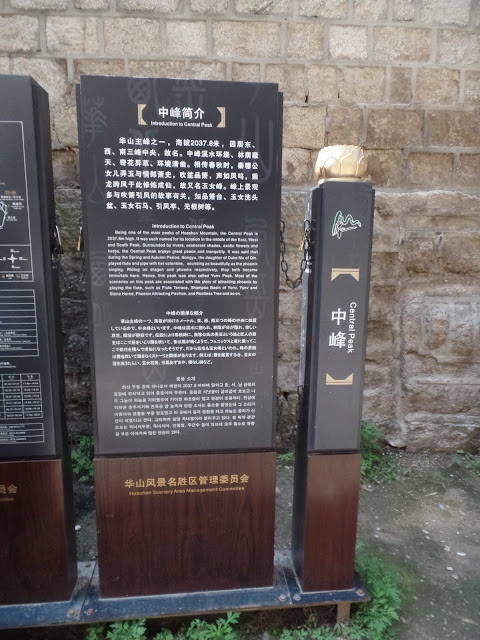 |
| Introduction to Central Peak |
 |
| Huashan Central Peak |
 |
| Golden Lock Pass |
North Peak (北峰)
Along the way, we passed by the Five Cloud Peak Hotel before the famous Cang Long Ling (苍龙岭), also known as the "Black Dragon Ridge". It is a very narrow pathway carved onto the mountain ridge, with steep cliffs on both sides. We did not use this pass, instead going down using another alternative path by the side of the ridge.
 |
| Scenic view en-route North Peak |
 |
| View of the Black Dragon Ridge |
 |
| View of the North Peak Cable Car Upper Station |
 |
| North Peak cable car tickets |
Back to Xi'an (西安)
We bought the cable car tickets and descended to the lower station. The cable car ride is much shorter than the one at West Peak (西峰), only around 8 min. At the cable car lower station, we purchased another set of shuttle bus tickets and ride onto the gold shuttle bus back to the Huashan Visitor Centre (华山旅客中心). From the Visitor Centre carpark, we took the free shuttle bus back to the Huashanbei Railway Station (华山北站). As we had already purchased our train tickets, it was still very early. We had an early dinner at one of the noodle restaurant just outside of the railway station. After the dinner, we waited some more before taking the high speed train back to Xi'an, followed by the Metro to our hotel area. It was still early and we decided to shop for souvenirs at the Muslim Street (回民街) before we depart Xi'an the next day.
Day 1: Beijing (Yonghe Lama Temple, Shizhahai, Prince Gong Mansion, Behai Park, Gui Jie)
Day 2: Beijing (Tiananmen Square, Forbidden City, Old Summer Palace, Wangfujing)
Day 3: Tianjin (Italian Style Town, Nanshi Food Street, Drum Tower, Ancient Cultural Street, Quanjude Peking Roast Duck)
Day 4: Xi'an (Muslim Street, Drum Tower, Bell Tower, Xi'an City Wall, Defu Alley)
Day 5: Xi'an (Terracotta Army Museum, Da Ci'en Temple, Big Wild Goose Pagoda, Tang Paradise)
Day 6: Huashan
Day 7: Beijing (Temple of Heaven, Silk Street)
Day 8: Beijing (Great Wall - Badaling, Ming 13 Tombs - Ding Ling, Shizhahai)
Day 9: Beijing (Summer Palace)
